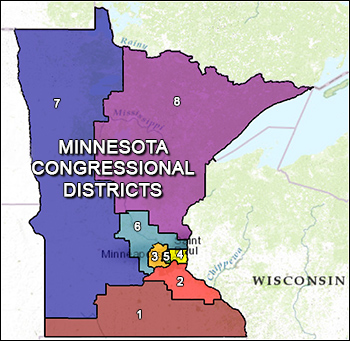Jan. 22, 2018 — A new political poll is providing more evidence that Minnesota is very much in play for the coming election. Analysts were surprised in 2016 when President Trump came within one percentage point of topping Hillary Clinton in the state, but that pattern seems to be holding, at least according to this latest data.
The last time Minnesota voted Republican in a presidential race was to re-elect President Richard Nixon in 1972, thus making this state the most consistently Democratic domain in terms of presidential election victories. Since the days when Hubert Humphrey and Eugene McCarthy represented Minnesota in the Senate, Republicans have only elected four senators during that stretch of 70 years. Their record of electing governors is a bit better, with seven individuals becoming the state chief executive during the same seven-decade time span.
Building upon President Trump’s strong showing and two Democratic House members, Reps. Tim Walz (D-Mankato) and Rick Nolan (D-Crosby/Duluth), winning re-election with 50.3 and 50.2 percent, respectively, the new Minneapolis Star Tribune’s Minnesota Poll (released Jan. 17; 800 registered Minnesota voters) suggests that we could again see similarly close results later this year.
While five different pollsters have released national generic vote congressional data since the first of the year giving Democrats an advantage from five to 17 points, the Star Tribune is producing much different numbers for the Minnesota electorate. (Quinnipiac University appears to be the outlier here with polls showing Dem advantages of 11 and 17 points, the only pollster to see a double-digit margin; they were thought to be the outlier in the Virginia governor’s race, too, but ended up being closest to the final result.)
According to this newspaper poll, voters in the Land of 10,000 Lakes would break only 47-45 percent for the Democrats in congressional races, while 94 percent of each party’s membership says they would support their own nominee in the general election.
Because of Sen. Al Franken’s (D) resignation, both Minnesota senators will be on the ballot this year. Sen. Amy Klobuchar (D), appearing in position to sail toward re-election, is running for a third six-year term. Newly appointed Sen. Tina Smith (D) must stand for election in November in order to serve the remaining two years of the term to which Franken won in 2014. With a candidate field now just beginning to form, Sen. Smith may face a strong challenge in her first election.
Of the state’s eight US House districts, one is open, and five look to have serious competition brewing.
While Rep. Walz is departing his southern Minnesota 1st District to run for governor, Republicans look ready to again field Jim Hagedorn, the man who held Walz to a one-point victory in the last election.
Democrats will go all out to unseat freshman Republican Jason Lewis (R-Woodbury) in the 2nd District after he slipped past former healthcare company executive Angie Craig, who lost 47-45 percent in the last election despite outspending her opponent by a 4:1 margin.
Despite fielding a major challenger against Rep. Erik Paulson (R-Eden Prairie) and Democratic nominee Terri Bonoff, a veteran state senator, spent just short of $2 million, the congressman recorded a strong 57-43 percent win. This year, Democrats have recruited businessman Dean Phillips who has the capacity to raise and spend much more than did Bonoff.
Veteran Rep. Collin Peterson’s (D-Detroit Lakes) 52-47 percent re-election victory was the closest race he’s had since his first re-election campaign in 1994, and against an opponent who didn’t even spend $20,000.
Finally, the re-match between 8th District incumbent Nolan and businessman Stewart Mills ended in a scant 50.1 – 49.6 percent Democratic win. Mills will not return for a third run, but Republicans have recruited St. Louis County commissioner and former professional hockey player Pete Stauber.
For Democrats to meet their quota goals for claiming the House majority, they need to hold all five of their Minnesota seats and defeat one of the Republican incumbents. These early polling numbers suggest such a goal may prove lofty.

